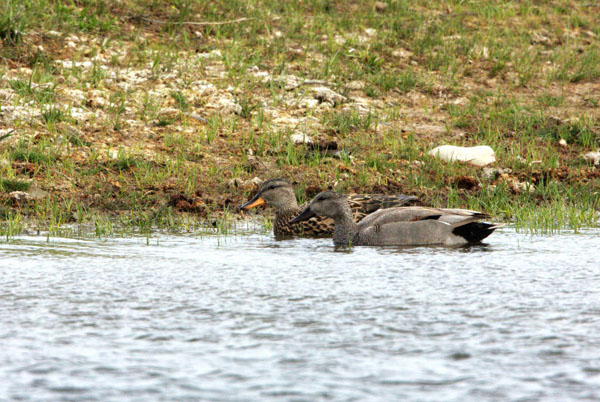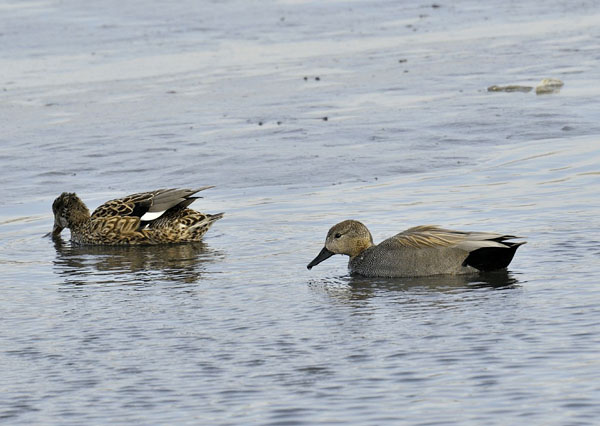Gadwall
IUCN
LCBasic Information
Scientific classification
- name:Gadwall
- Scientific Name:Green edge boy, beautiful scenery,Anas strepera,Gadwall
- Outline:Waterfowl
- Family:Anseriformes Anseriidae
Vital signs
- length:44-55cm
- Weight:0.7-1kg
- lifetime:19years
Feature
The male has a black bill and orange-yellow feet. The female beak is orange and the peak black.
Distribution and Habitat
The Chinese breed in Northeast China and Xinjiang, transiting most of central and eastern China during migration, and wintering in the Yangtze River and its southern waters, Taiwan Island. It breeds abroad in temperate waters of the northern border and overwinters in the southern part of the Northern border, including East and North Africa.
Like to inhabit and activities in rivers, lakes, reservoirs, river bays, ponds and swamps and other inland waters, non-breeding period, more groups of activities in freshwater rivers, lakes and swamp waters, habitat of aquatic plants, occasionally appear in the seaside swamp area, often with other river ducks and diving ducks mixed.
Appearance
The male bird is gray and densely covered with verm-like white lines, black wings with brownish-red patches, white wing mirrors, and black tail. Female gray-brown with yellowish-brown spots and scaly spots on both flanks, resembling mallard females, but with white wing mirrors and small body size and white belly. The irises are brown, the bill black (male) or orange-yellow (female), and the feet orange.
Details
Anas strepera (Anas strepera) is a medium-sized duck that is slightly smaller than domestic ducks, often living in small flocks, and likes to mingle with other wild ducks. Sex timid and alert, when there is danger immediately rushed out of the water grass. Flying extremely fast, the wings flap fast and powerful.

Mainly aquatic plants. It often forages among the grass at the water's edge. When foraging for food, the head is often submerged in the water, and sometimes the head is upside down and the tail is upside down in the water to eat. Foraging time is mostly in the early morning and dusk, and rest on the open water during the day. In addition to eating aquatic plants, they often forage for grass, seeds, berries and grains on shore or in farmland.
Spring is seen in North China from mid-March to the end of March, and in Northeast China from late March to mid-April, some of which remain to breed locally, and the rest continue to migrate north. Autumn occurs in the southern part of Northeast China from late September to mid-late October, and moves to North China from late October to mid-November. In late November, a large number of people reached the southern wintering ground. Migration often occurs in groups of families or small groups of families.

Breeding season May to July, when moved to the breeding ground has pairs. Nest in the grass or bushes near the water, the nest is very hidden, and sometimes it is far away from the water. The nesting area is large, but on some small islands with good nesting conditions, the nests are sometimes very dense. Each clutch lays 8-12 eggs, usually 10, 1 per day. Incubation is undertaken by the female bird, but in the early incubation period, the male bird often waits near the nest, and then leaves the female bird to moult in a secluded place, the incubation period is 26 days. Soon after the chicks hatch, the female leads the chicks to deeper swamps or large water edges, 50-60 days before the chicks can fly.

There are two subspecies, of which Fanning subspecies has been extinct, but the named subspecies is widely distributed and abundant. In 1970, the population was estimated to be 1.5 million in North America alone, 10,000 in northwestern Europe, 50,000 in the Black Sea and Mediterranean regions of Europe, and 163,000 pairs in the western Soviet Union. According to the Asian midwinter waterbird survey organized by the International Waterfowl Research Bureau in 1992, there were 52,785 waterbirds in West Asia, 155,124 in South Asia, 9,187 in East Asia, of which 5067 were in China.








